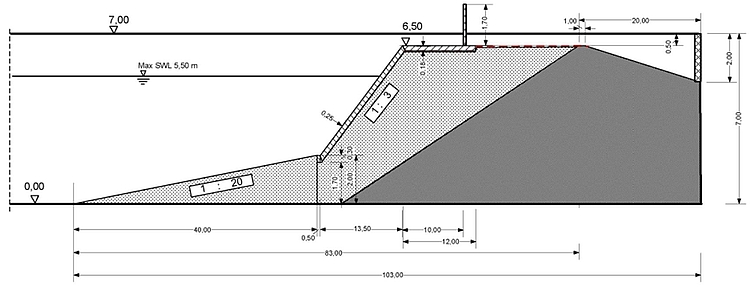Impact loads on vertical storm walls by overtopping waves

| Led by: | Prof. Dr. Ir. Julien de Rouck |
| Year: | 2011 |
| Funding: | Ghent University |
| Remarks: | 2 weeks |
Sea dikes have been built along the Belgian coast for protecting vulnerable parts of the coastline and the hinterland from the ocean wave actions. However, there is a high possibility that the dikes could be overtopped by violent wave actions during the storm, and this could flood the cities which are lying below the mean sea level. Therefore, in order to minimize the overtopping volume, it was proposed to build a storm wall on top of the dike.
Although extensive research has been done on breaking wave impact on coastal structures, impact loads by overtopping bores have rarely been studied. Thus, a test program to investigate the impact on storm walls by overtopping waves was conducted by Ghent University (UGent) and FZK in the Large Wave Flume (GWK). A series of experiments were performed for both regular waves and irregular waves (JONSWAP).
All the tests were carried out at 1:1 scale on a dike with a crest height of 6.5 m followed by a horizontal section of about 10 m where two walls of 1.7 m x 0.5 m (vertical wall) and 0.5 m x 1.7 m were installed. As shown in Figure.1 there is another horizontal section behind the storm wall followed by a storage volume to collect the overtopping water and pump it back into the flume. The main peak period was 12 s and freeboards of 1 m (water depth D = 5.5 m) and 2 m (D = 4.5 m) were investigated.
FZK provided the fully prepared dike along with standard wave gauges, pressure sensors, propeller probes and gauges to measure the thickness of the overtopping water volume. The two walls including complete measurement equipments for the force and impact pressure measurements were provided by Ghent University (Figure.2). There were mainly three measurements made during the testing:
Impact pressures / forces
There were 4 Force transducers mounted at the corners of each horizontal and vertical plate and 8 pressure transducers were installed at the middle of the vertical plate with 20 cm interval. FZK pressure transducers were also placed beside the UGent pressure sensors on the vertical plate for the comparison of both measured values.-
Flow velocities of the overtopping waves
Three velocity propellers were installed on the 10 m horizontal platform. -
Flow depth of the overtopping waves
Multiple measurements over the 10 m dike were performed for the flow depth.
According to the model setup, the incoming wave first breaks in the vicinity of the dike and overtops the dike crest. The overtopped water flows over the horizontal section of the dike and then hits the storm wall, and overtops again as shown in Figure.3. Part of the incoming waves overtopped the storm wall whereas the rest of the water was reflected and flow back into the flume. It was observed that the collision of reflected waves and the incident waves occurred at different points of the horizontal platform, which reduces the energy of the incoming waves.
Reflection analyses were performed using measurement from four wave gauges to determine the incident wave height in front of the wall. The individual volumes which overtop the crest of the dike can be calculated from the measurements obtained from the flow depth and velocity measurements. The individual overtopping volume of waves then can be compared with the corresponding impact pressures. Analysis is still going on.
